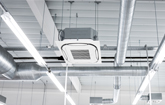Honeywell Connects More Than 2 Million Homes and Utilities to Keep the Lights On and Cool Air Flowing
-- Honeywell Helps Homeowners Save Money and Trim Energy Use Equal to 20 Times the Power Needed for NFL Stadiums on Game Day
-- Consumer Technology that Controls Energy Costs and Consumption also Helps Reduce the Potential for Outages and Need for New Power Plants
-- Broad Use of Technology Could Cut Demand for Electricity in the US by 19 Gigawatts
MINNEAPOLIS, Sept. 12, 2013 /PRNewswire/ -- On the hottest days of the year, utilities need to ramp up the generation of electricity by as much as 60 percent, mainly to account for air conditioners set to deep freeze. That means additional kilowatts and power plants are required as more homes, buildings and air-conditioning units tap into the energy grid. A long-standing and rapidly evolving alternative, however, is for consumers to help produce "negawatts" — basically to reduce electricity use when there is maximum stress and strain on power lines and other equipment.
More than 2 million homeowners across North America are using Honeywell (NYSE: HON) thermostats, along with load-control switches installed by the company, to help more than 100 utilities reduce the potential for outages and decrease the need for new power plants. These homes, equivalent to all the households in Chicago, Philadelphia, Seattle and Orlando, have received incentives from their utilities to assist in making the grid more reliable.
As a result of Honeywell's technology and services, utilities now have the combined ability to temporarily trim the demand for energy by 2.1 gigawatts, almost 20 times the power needed to operate all the NFL stadiums on any given Sunday. And there is significant potential to decrease peak use further; if only 25 percent of homes in the U.S. with central air employed similar technology, the country could cut demand by an estimated 19 gigawatts.
"Our extensive work with utilities and their customers gives Honeywell a distinct understanding of what it takes to make this type of collaboration successful," said Jeremy Eaton, vice president and general manager of Honeywell Smart Grid Solutions. "However, we're not standing still. Consumers expect technology that delivers comfort and cost savings without a 20-page manual. And utilities are searching for new ways to stabilize the grid while increasing customer satisfaction. No other company can connect utilities and customers at this level, at this scale, and address all these needs."
The main reason utilities provide programs that encourage customers to curb electricity consumption is simple: When temperatures and electricity use spike, the potential for energy disruptions increases, and the cost for the utility to generate or purchase the necessary power can double or even triple, which could impact long-term electricity rates for consumers. The ability to boost generation helps, but few communities want a new power plant or are willing to consider funding construction without exploring more cost-effective and sustainable options.
Working with Honeywell and homeowners, utilities can develop strategies to reduce the use of residential air conditioners, water heaters and other equipment for a short time, also known as demand response. The shift in temperature is often negligible, but the collective decrease in consumption helps promote the availability of energy across the entire grid.
For consumers, there are multiple benefits to participating. These benefits may include payments or bill credits from their local utilities — and people who sign up for Honeywell-led programs often receive new equipment that helps make homes more comfortable and efficient.
Honeywell already has one of the most widely used demand response thermostats, which
is installed in more than 600,000 homes across North America. The company also has a new thermostat with Wi-Fi and app connectivity since residences are increasingly connected. These features not only make programs and participation more appealing, but typically increase the potential energy reduction per home because of the additional intelligence in the device.
"The technology is evolving, merging with smartphones, tablets and other devices people use on a daily basis," Eaton said. "It just means more convenience, comfort and control."
Visit honeywellsmartgrid.com or follow HoneywellGrid on Twitter for more information smart grid technology and services. And for details on Honeywell's full line of Wi-Fi-connected thermostats, link to wifithermostat.com.
Honeywell (www.honeywell.com) is a Fortune 100 diversified technology and manufacturing leader, serving customers worldwide with aerospace products and services; control technologies for buildings, homes and industry; turbochargers; and performance materials. Based in Morris Township, N.J., Honeywell's shares are traded on the New York, London, and Chicago Stock Exchanges. For more news and information on Honeywell, please visit www.honeywellnow.com.
This release contains certain statements that may be deemed "forward-looking statements" within the meaning of Section 21E of the Securities Exchange Act of 1934. All statements, other than statements of historical fact, that address activities, events or developments that we or our management intends, expects, projects, believes or anticipates will or may occur in the future are forward-looking statements. Such statements are based upon certain assumptions and assessments made by our management in light of their experience and their perception of historical trends, current economic and industry conditions, expected future developments and other factors they believe to be appropriate. The forward-looking statements included in this release are also subject to a number of material risks and uncertainties, including but not limited to economic, competitive, governmental, and technological factors affecting our operations, markets, products, services and prices. Such forward-looking statements are not guarantees of future performance, and actual results, developments and business decisions may differ from those envisaged by such forward-looking statements. We identify the principal risks and uncertainties that affect our performance in our Form 10-K and other filings with the Securities and Exchange Commission.
| Aaron Parker |
Marie Yarroll |
| 763-954-4257 (office) |
763-954-6071 (office) |
| 763-607-6108 (mobile) |
763-350-0434 (mobile) |
SOURCE Honeywell
WANT YOUR COMPANY'S NEWS FEATURED ON PRNEWSWIRE.COM?
Newsrooms &
Influencers
Digital Media
Outlets
Journalists
Opted In





Share this article